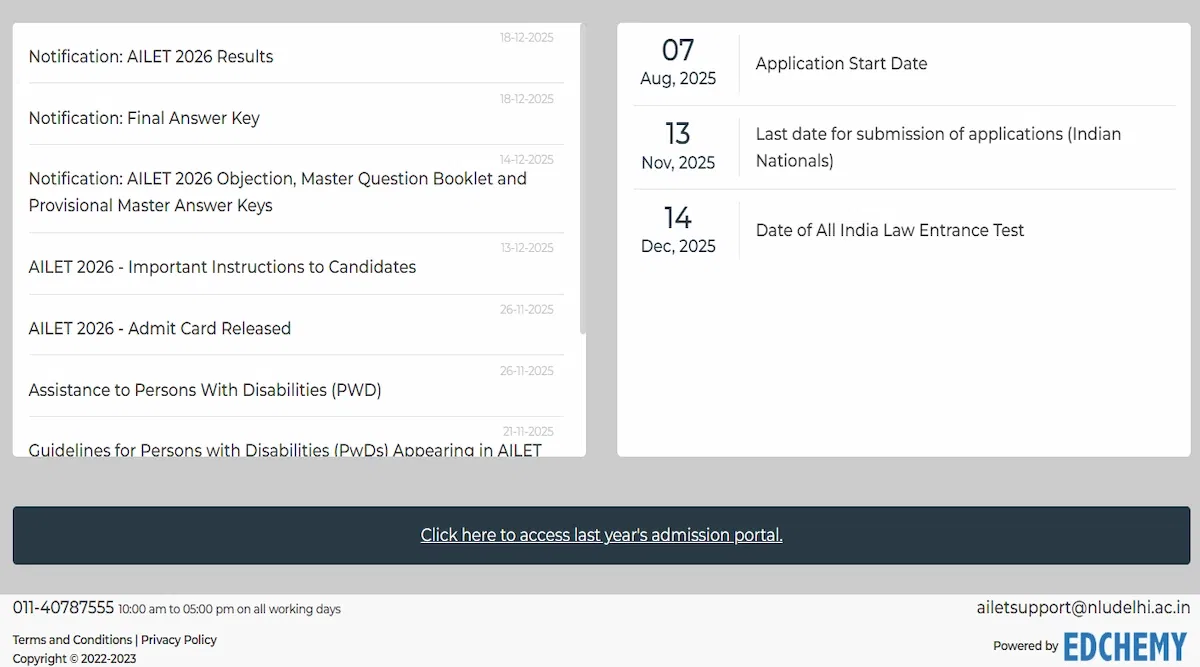There are multiple difference between CLAT and AILET in terms of exam pattern, syllabus, and admission criteria. However, AILET is considered comparatively more difficult than CLAT.
Table of Contents
There are multiple factors in terms of difference between CLAT and AILET, such as the mode of examination, the exam pattern, and more. Both exams are highly competitive. Candidates can appear for two of the examinations or anyone as per their choice.
CLAT (Common-Law Admission Test) and AILET (All India Law Entrance Test) are national-level law examinations. Hence, knowing the difference between CLAT and AILET becomes essential. However, the CLAT syllabus is considered somewhat similar to AILET syllabus.
Key Differences Between CLAT and AILET
The difference between CLAT and AILET are many. The exam mode, pattern, and time differ from one another. In addition, the CLAT exam pattern 2026 underwent certain changes last year.
The examination committee has reduced the questions to 150 and increased the passage-based questions in the individual section. However, the AILET exam pattern remains unchanged.
CLAT vs AILET Syllabus
The syllabus for both exams is pretty much the same. The only difference between CLAT and AILET exams is that in AILET, we have mathematics, while in CLAT, it is quantitative ability.
Rest follow the list to learn the questions from each subject of the CLAT 2026 syllabus:
CLAT Syllabus
English Language
- Passages
- Correcting Incorrect Grammar Sentences
- Fill in the Blanks
- Synonyms & Antonyms
- Spotting Grammatical Errors
- Tenses
- Active & Passive Voice
General Knowledge (inclusive of Current Affairs)
- Recent Events of National and International Importance
- History
- Art & Culture
- Awards & Honours
- Eminent Personalities Sports
- Economy
- Science
Also Check: CLAT Important Topics Weightage
Legal Reasoning
- Legal Maxims
- Indian Constitution
- Important Supreme Court Judgments
- Important Acts and Amendments of the Legislature
- Legal GK
- Current Affairs
Logical Reasoning
- Relationships
- Analogies
- Logical Sequences
- Syllogism
- Statement & Assumption
- Cause & Effect
- Inferences
- Premises & Conclusion
Quantitative Ability/ Mathematics
- Algebra
- Ratios and Proportions
- Mensuration
- Statistics
- Pie Chart
- Bar Graph
- Line Graph
- Table Chart
AILTET Syllabus
English Language
- Fill in the blanks
- Comprehension passages
- Antonyms & Synonyms
- Idioms and phrases
- Jumble words and sentences
- Choosing the correct words
General Knowledge (inclusive of Current Affairs)
- International events
- UN bodies
- Significant advancements in the fields of sports, environmental agreements & geopolitics
- Current affairs
- Eminent personalities
- Sports
- Awards and honours
Also Check: How to Become a Lawyer?
Legal Reasoning
- Vicarious Liability
- Strict Liability
- Law of Crimes
- Contracts and Constitutional Law
- International Law
- Intellectual Property Rights
- Legal Awareness covering Constitutional Law and Polity
Logical Reasoning
- Series
- Blood Relations
- Directions
- Critical Reasoning
- Syllogism
Quantitative Ability/ Mathematics
- Algebra
- Profit and loss
- Time and work
- Average, speed and distance
- Permutation-combination and Venn diagrams
- Numerical ability
CLAT vs AILET Question Distribution
Tabulated below is the difference between CLAT and AILET subject-wise number of questions and marks distribution is as follows:
| Subjects | CLAT | AILET | ||
| Total Questions | Distribution of Marks | Total Questions | Distribution of Marks | |
| English Language | 28-32 | 28-32 | 35 | 35 |
| General Knowledge (inclusive of Current Affairs) | 35-39 | 35-39 | 35 | 35 |
| Legal Reasoning | 35-39 | 35-39 | 35 | 35 |
| Logical Reasoning | 28-32 | 28-32 | 35 | 35 |
| Quantitative Ability/ Mathematics | 13-17 | 13-17 | 10 | 10 |
CLAT vs AILET Exam Pattern
CLAT and AILET both are competitive law entrance exams. Therefore, learning the CLAT exam pattern and AILET exam pattern as well as following the same is mandatory.
Hence, for the benefit of the candidates, we have mentioned the difference between CLAT and AILET exam pattern in the table below:
| Particulars | CLAT | AILET |
| Full-Form | Common-Law Admission Test | All India Law Entrance Test |
| Conducting Authority | National Law University Odisha (NLUO), Cuttack | National Law University, Delhi |
| Level of Examination | National level Exam | National level Exam |
| Mode of Examination | Online, i.e. Computer-Based Test (CBT) | Offline |
| Medium of Answering | English | English |
| Duration of Exam | 120 Minutes | 90 Minutes |
| Questions | MCQs and Comprehensions | Objective MCQs |
| Frequency | Annually | Annually. |
Also Check: Cyber Law Courses
CLAT Vs AILET Eligibility Criteria
The eligibility criteria for CLAT and AILET eligibility criteria are almost similar. However, the minimum requirement for both admissions is stated initially in this article.
Below mentioned is the difference between CLAT and AILET eligibility criteria is as follows:
| Category | CLAT | AILET |
| Unreserved/OBC/Specially Abled | 45% | 50% |
| SC/ST | 40% | 50% |
Also Check: How to Crack AILET Exam
CLAT vs AILET Examination Fees
The CLAT and AILET exams are quite alike, but the fee differs. It is observed that there is a considerable difference between CLAT and AILET application fees. The fee structure is displayed below:
| Category | CLAT | AILET |
| General Category/ Other Backward Class (OBC)/ Persons with Disability (PwD) | INR 4,000 | INR 3,050 |
| Persons of Indian Origin (PIO) | INR 4,000 | INR 3,050 |
| Overseas citizens (OCI) | INR 4,000 | INR 3,050 |
| Non-Resident Indians (NRI) | INR 4,000 | INR 3,050 |
| Kashmiri Migrant | INR 4,000 | INR 3,050 |
| Scheduled Class (SC)/ Scheduled Tribe (ST) | INR 3,500 | INR 1,050 |
| Below Poverty Line (BPL) | INR 3,500 | No application fee is charged. |
Also Check: Top Government Law Colleges in India
CLAT vs AILET Competiton Level
In terms of competition, the two tests are very different. The battle is fierce since AILET only gives a few places and that too to only one participating university, which also happens to be one of India's top NLUs.
This isn't to imply that passing CLAT and securing a spot in one of the 22 NLUs is easy. When compared to AILET, however, CLAT has a lower level of competitiveness.
CLAT vs AILET Pros and Cons
Cracking AILET is a remarkable achievement by itself. An NLUD tag coupled with extensive knowledge about the field will shine bright in any student’s CV. On the other hand, extreme competition is a con.
Only a few handfuls of students are able to crack this exam and the failure rate is high.
Whereas, CLAT is a less competitive exam. Compared to AILET, CLAT has a higher success rate and has more available seats as well. Candidates with a lower CLAT score are more likely to enrol at NLUs that are not their first choice.
Candidates should keep in mind, however, that all of the NLUs are reputable law schools with a reputation for providing high-quality education.
However, they lack several essential benefits, like industry connections and placement, as compared to the top NLUs.
Also Check: Law Colleges Accepting CUET
CLAT Vs AILET Which is Tougher?
It is an honest query among candidates, which is hard: CLAT or AILET.
However, if you go by the seat count, CLAT is easier than AILET. Furthermore, every year for 3283 seats at 22 NLUs, approximately 59,000 candidates appear. At the same time, 19,000 candidates appear for 180 seats at NLU Delhi. It is one of the key difference between CLAT and AILET.
Therefore, according to the basic calculation (approx), 17 candidates contest for one seat in NLU, whereas 105 candidates compete for one seat in NLU, Delhi. However, the candidates can appear for both examinations: CLAT and AILET.
Besides, the AILET question paper has a tough legal aptitude paper, and it deals with the core of the law, which is on the tougher side.
Besides, the CLAT Consortium has revised the test paper by raising comprehensive questions to make it more manageable for candidates.
Also Check: Law Courses After 12th
CLAT Vs AILET Which One to Choose?
AILET and CLAT come with their perks and drawbacks; it is sensible to arrive for both examinations. However, there are two reasons for the deliberation:
- AILET is held before CLAT. Thus, candidates acquire an opportunity to analyze the kind of questions that may come for CLAT.
- Through AILET, candidates gain an opportunity to obtain a seat among the NLUs. While through CLAT, the opportunity enhances.
Candidates can any day opt for the law entrance exam according to their choice. However, when they get an opportunity to apply, it is recommended to apply for both.
Also Check: LSAT vs CLAT
Top Law Colleges Accepting AILET Exam
After knowing the difference between CLAT and AILET, there are many prestigious colleges accepting AILET scores. Candidates are advised to follow the eligibility criteria for each of these colleges and apply accordingly.
- NLU Delhi - National Law University
- NorthCap University, Gurgaon
- Vishwakarma University, Pune
- Sushant University, Gurgaon
- Jagannath University, Jhajjar
- SAGE University, Indore
- Xavier Law School, Bhubaneswar
Also Check: Best Law Colleges in India Without CLAT
Top Law Colleges Accepting CLAT 2026
Top law colleges consider CLAT scores for admissions. However, candidates are advised to track the eligibility criteria set by each listed college and apply for admissions if they satisfy the standards.
- School of Law, University of Petroleum and Energy Studies, Dehradun
- CMR University School of Legal Studies, Bangalore
- NLU Hyderabad - NALSAR University of Law
- Bennett University, Greater Noida
- IIL Indore - Indore Institute of Law
- GITAM School of Law Visakhapatnam - School of Law GITAM University
- VIT Law School, Chennai
Also Check: Top 10 CLAT Colleges in India
























POST YOUR COMMENT